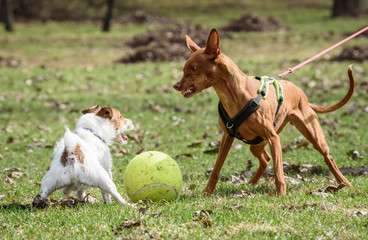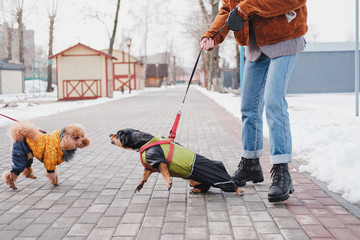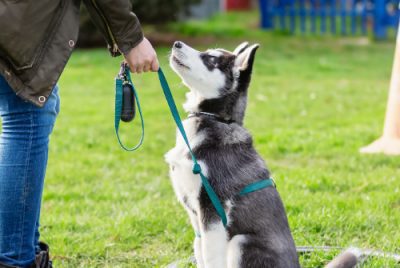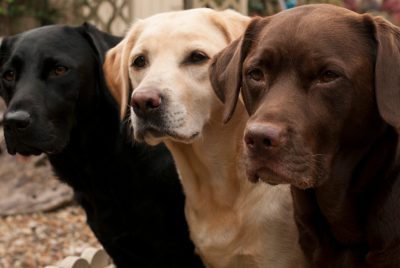Handling Dog Aggression: Best Tips for Success
Post Disclaimer
We may earn a commission for purchases made using our links. Please see our Disclaimer to learn more.
Tips for Dealing with Dog Aggression
Why is my dog displaying aggression towards other dogs?
Many dog owners become concerned when their pets show signs of aggression. It can be distressing to witness behavior whether you have a puppy or an older dog with a history of aggression. Aggression can be directed toward strangers, family members, or other dogs. Understanding how to address this issue is crucial for the well-being of your dog and others involved. In this blog, we will discuss ways to recognize signs of aggression, comprehend its forms, and explore training methods. Whether you have a puppy or an older dog exhibiting behavior, it is important to consider how to introduce dogs and socialize your puppy effectively in order to prevent conflicts between the new addition and the existing older dog. These tips will assist you in managing this issue empathetically.
Understanding Dog Aggression
To effectively address behavior in dogs, it is important to have an understanding of what causes it and why it occurs. Dogs may exhibit aggression through behaviors like growling, barking, lunging, or biting as a result of fear, anxiety, or territorial instincts. It is crucial to recognize that every dog has their personality and specific triggers that can lead to behavior. By gaining an understanding of dog aggression, we can determine approaches to managing and rectifying it.

Common Causes of Dog Aggression
Dog owners should be aware of common causes of aggression in dogs. Causes include fear, anxiety, lack of socialization, genetics, or misunderstanding of human behavior. Some dogs may show aggression to establish dominance or protect resources like food or toys. Understanding dog aggression requires recognizing signs from body language and vocalizations.
Fear and Anxiety in Dogs
Fear and anxiety can cause dogs to display aggression. When a dog feels scared, uncomfortable, or anxious, they may respond by becoming aggressive as a means of self-protection. Signs of fear in dogs can include trembling, excessive panting, incessant barking, or attempts to flee. Separation anxiety is a form of anxiety among dogs. This can often result in aggressive behavior when they feel distressed about being separated from their owner. Older dogs may also exhibit aggression due to health issues, pain, or cognitive decline. If a dog struggles to express their anxiety, their behavior might manifest as aggression. To effectively manage dog aggression it is crucial to comprehend and address the fear and anxiety that drive it.
Recognizing Signs of Aggression
To deal with dog aggression, know the signs: physical and behavioral. Physical signs include tension, eye contact, raised fur, and exposed teeth. Behavioral signs include growling, lunging, snapping, and threatening postures. Recognizing these signs lets owners react to ensure safety and well-being.
Physical Signs
Dogs can show aggression through their body language, facial expressions, and sounds they make. These signs help us determine if a dog is aggressive. Signs include tense bodies, direct eye contact, raised fur, and exposed teeth. Growling, barking, and snarling are also common. Sometimes owners use a muzzle to prevent aggressive behavior while training them. It’s important for owners to understand these signs to intervene when necessary and address the aggression.
Behavioral Signs
Dog owners should learn to identify signs of aggression in their pets. These may be physical or behavioral, including growling, lunging, and threatening postures. Aggression can stem from fear, anxiety, arousal, or dominance. It’s vital to distinguish between aggressive body language and assertive behavior since dogs may show assertiveness without being aggressive. Being mindful of these signs will help dog owners modify their pet’s behavior using suitable training methods while ensuring everyone’s safety.
Types of Dog Aggression
Different types of dog aggression have unique underlying causes and management strategies. It’s crucial to recognize and understand these types to address aggressive behavior in dogs. The three primary types are territorial, predatory, and fear-induced aggression. Identifying your dog’s specific type can help guide effective training techniques.
Territorial Aggression
Territorial aggression happens when a dog is aggressive towards intruders in their space, such as their home, yard, or specific areas. The dog displays signs of dominance and protects its resources. Recognizing the body language and behaviors associated with territorial aggression is crucial. This includes barking, growling, or an assertive posture. Proper management, training, and behavior modification techniques can help manage territorial aggression effectively.
Predatory Aggression
Dogs may have predatory aggression because of their natural instinct to chase, capture, and hunt prey. When dogs have it, they may focus intensely on small animals or fast-moving objects. Recognizing the signs of predatory aggression, like stalking, chasing, and showing high excitement, is important. Managing this type of aggression involves preventing it with leash management, redirecting focus, providing mental stimulation, and establishing clear dominance as the alpha dog in the household.
FearDriven Aggression
Sometimes, dogs can exhibit aggression when they experience fear, discomfort, or anxiety. Signs that a dog is fearful may include shaking, hiding, or attempting to escape. To assist dogs dealing with fear-induced aggression, it’s crucial to identify fear signals and establish a comforting environment for them. Seeking assistance can also be beneficial in this situation. Utilizing techniques such as desensitization, counter-conditioning, and positive reinforcement can aid dogs in overcoming their fears and reducing behavior.
Handling Dog Aggression
Dealing with dog aggression requires taking quick action to ensure safety and seeking professional help. Knowing how to handle aggressive behavior and the significance of expert advice can help pet owners gain control and create a secure space for everyone involved.
Immediate Steps to Take
Managing dog aggression requires immediate steps to ensure your dog’s and others’ safety. Here are some immediate actions to consider:
- Keep a safe distance from the aggressive dog, avoiding any physical confrontation.
- Use a basket muzzle, if necessary, to prevent any potential bites or attacks.
- Securely leash your dog, ensuring you can safely control their movements.
- Create distance between yourself and the aggressive dog, moving away calmly and confidently.
- Seek professional help, such as consulting a veterinarian or certified dog behaviorist, to assess the underlying causes of aggression and develop a personalized training plan.
Importance of Professional Help
Getting assistance is crucial when dealing with dog aggression. It’s important to consult a veterinarian or a certified dog behaviorist who can offer expert guidance and support. They can accurately identify the causes of aggression, create a behavior modification plan, and ensure your dog’s well-being. Remember, there are factors, like fear, anxiety, or past trauma, that may contribute to aggression in dogs, requiring the expertise of professionals to address effectively. Approaching your dog’s behavior with empathy, compassion, and respect for their well-being is always the approach. With help, dog owners can gain insights, learn appropriate training techniques, and ensure the safety of everyone involved.
Techniques to Control Dog Aggression
After taking immediate steps to ensure safety, implementing techniques to control dog aggression is crucial. Using positive reinforcement, obedience training, leash management, and socialization methods can help modify behavior, create positive experiences, and reduce aggressive tendencies.
Basic Obedience Training
Teaching your dog basic obedience is crucial when dealing with dog aggression. By training commands like “sit,” “stay,” and “leave it, ” you can set boundaries, improve communication and establish an environment for your pup. Obedience training helps dogs respond well to commands, which in turn reduces the chances of behavior. During training sessions, it’s important to provide experiences, rewards, and praise to reinforce behavior, foster trust, and develop a strong bond between you and your furry companion.
Leash Training
Leash training is highly recommended for handling dog aggression. Walking a dog while they are on a leash allows you to have control, ensuring the safety of everyone involved. Proper leash training involves teaching your dog to walk without pulling or lunging, which can effectively decrease behavior. It is important to maintain a distance from triggers such as other dogs or stressful environments and redirect your dog’s attention using positive reinforcement techniques while on a leash. Additionally, muzzle training can be beneficial during vet visits if your dog finds them stressful or if they tend to eat things they shouldn’t when outside.
Socialization Methods
Socialization plays a vital role in preventing and addressing dog aggression. Here are some effective socialization methods:
- Introduce your dog to new people, dogs, and environments from an early age.
- Provide positive experiences during socialization, such as supervised playdates with well-behaved dogs or controlled interactions with new people.
- Encourage positive associations by rewarding calm behavior, good manners, and appropriate social interactions.
- Gradually expose your dog to different situations, ensuring they have positive experiences with a range of people, animals, and environments.
- Seek professional guidance to address any issues or challenges during socialization, particularly if your dog displays signs of aggression.
Long-Term Solutions for Dog Aggression
Addressing the causes of dog aggression requires more than immediate steps and training techniques. It’s important to implement long-term solutions that focus on desensitization and counter-conditioning, avoiding triggers, and potentially utilizing medication or other interventions when necessary.
Desensitization and Counter-Conditioning
To address behavior in dogs, trainers often utilize desensitization and counter techniques. Desensitization entails exposing the dog to triggers in a controlled, positive manner. Counterconditioning involves creating associations by pairing previously fear-inducing stimuli with enjoyable experiences. It is crucial to seek professional guidance when modifying a dog’s behavior, as it requires planning, expertise, and knowledge of the dog’s behavior and individual triggers.
Avoiding Triggers
Managing dog aggression involves avoiding triggers. Identify and understand specific triggers like food aggression, fear of strangers, or territorial behavior that induce aggression in your dog. Recognize signs of aggression like growling, snapping, or assertive body language. Remove your dog from triggering situations to keep them and others safe. Use management strategies like securely storing food and possessions, managing interactions with unfamiliar individuals, or using visual barriers to reduce aggressive behavior frequency. In some cases, one dog may establish dominance over others, becoming the top dog in certain situations.
Medication and Other Interventions
If your dog displays aggression, there may be a need for medication or other interventions. In cases where behavior modification alone is insufficient, it’s advisable to consult a veterinarian for assistance. They will carefully observe your dog’s behavior, evaluate the situation, and prescribe any medication. Medication can effectively address issues such as anxiety, fear, or aggressive tendencies, ultimately facilitating the modification of their behavior. Depending on your dog’s needs, experts may also recommend therapy sessions, training programs, or alternative therapeutic approaches. It is crucial to seek guidance to determine the suitable path forward for your dog’s overall well-being.
Success Stories and Case Studies
Understanding real-life experiences and success stories of dealing with dog aggression can offer valuable insights and inspiration to dog owners who may be facing similar challenges.
Dealing with Fear-Based Aggression; A Real-Life Example
Fear-based aggression is a type of dog aggression. Let’s delve into a real-life case to gain an understanding of this form of aggression and learn how to address it
Real-Life Example: Meet Lucy, a two-year-old Border Collie who exhibited fear-based aggression towards strangers. Whenever someone approached her, she would. Bark. Concerned about Lucy’s behavior, her owner, Sarah, sought assistance. A dog behaviorist assessed Lucy’s behavior, identified her triggers, and devised a training plan that involved desensitization techniques along with reinforcement.
By exposing Lucy to unfamiliar people from a distance, her fear gradually diminishes over time. Sarah. Praised Lucy for remaining calm and for interactions with new individuals. With training and guidance from the professional, Lucy grew more at ease around strangers. Ceased displaying aggressive behavior altogether. Thanks to the intervention by the dog behaviorist, Sarah successfully tackled Lucy’s fear-based aggression, resulting in a happier environment for both the dog and her owner.
How can dog owners ensure the safety of others while handling an aggressive dog?
Handling an aggressive dog requires responsible actions to ensure your dog’s and others’ safety. Here are some essential tips:
- Keep a safe distance from other dogs, individuals, or situations that may trigger your dog’s aggression.
- Use a muzzle during walks or when in public spaces to prevent any potential bites or attacks.
- Always keep your dog on a leash, ensuring you have control over their movements and can prevent any aggressive behavior.
- Educate yourself about dog body language, aggression signs, and safe handling techniques.
- Seek professional help to understand and address your dog’s aggression effectively, ensuring the safety of everyone involved.
Frequently Asked Questions
My dog is aggressive around other dogs. What should I do?
If your dog displays aggression toward other dogs, taking appropriate steps to address and manage the behavior is crucial. Here are some recommendations:
- Consult a professional, such as a certified dog trainer or behaviorist, to assess the underlying causes of the aggression and develop a customized training plan.
- Avoid exposing your dog to situations that trigger their aggressive behavior until you have professional guidance and a training plan in place.
- Gradually introduce your dog to other dogs in controlled environments, such as obedience classes or monitored playdates, under professional supervision.
- Use positive reinforcement training to reward good behavior, calmness, and appropriate social interactions.
- Consistency, patience, and professional guidance are key when working with an aggressive dog, particularly around other dogs.
What do you do if an aggressive dog approaches your dog?
Encountering an aggressive dog while walking your own dog can be a tense situation. Here’s what you can do:
- Stay calm and avoid making direct eye contact with the aggressive dog, which can escalate the situation.
- Use a firm, confident voice to command your dog to stay close to you or back away from the aggressive dog.
- Create distance between your dog and the aggressive dog by moving in another direction.
- Use a muzzle on your dog to prevent any potential aggressive behavior, ensuring both dogs’ safety.
- If the situation escalates and you fear for your safety, seek immediate assistance from animal control or a professional dog handler.
Conclusion
Dealing with dog aggression involves understanding the root causes, recognizing signs of aggression, and handling techniques. It’s crucial to address aggression promptly and seek professional help if needed. Training and socialization can control aggression, while desensitization, avoiding triggers, and medication are long-term solutions. Remember, every dog is unique. Therefore, it’s essential to tailor your approach based on their specific needs and consult with experts when necessary. With patience and consistency, you can help them overcome aggression and lead a happier life.





